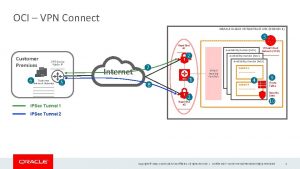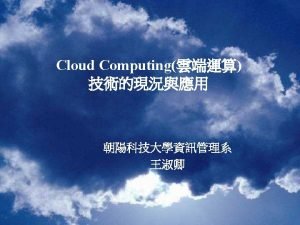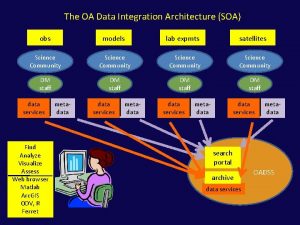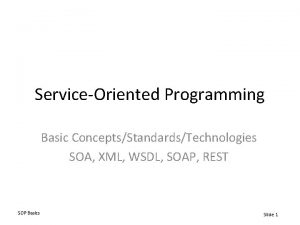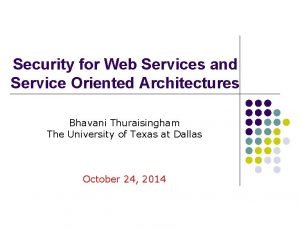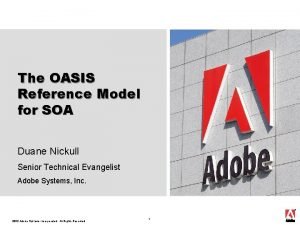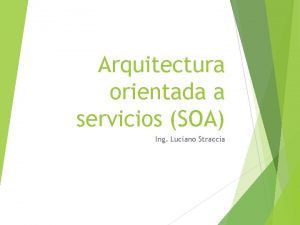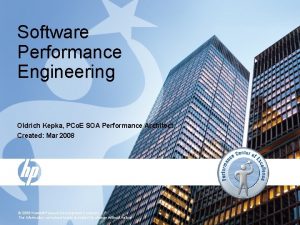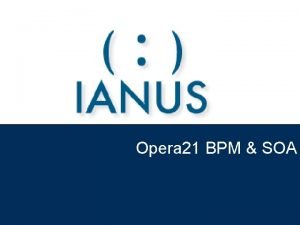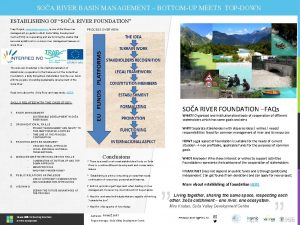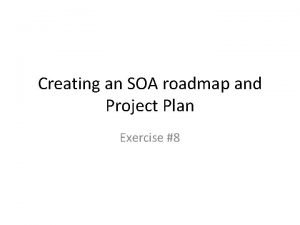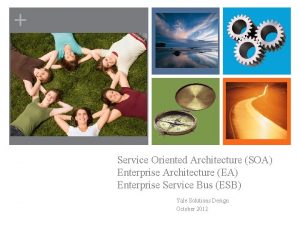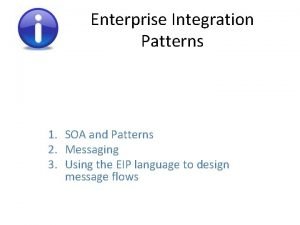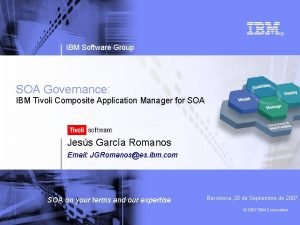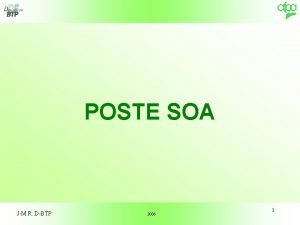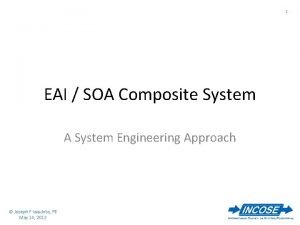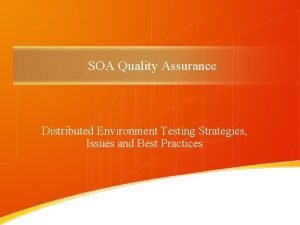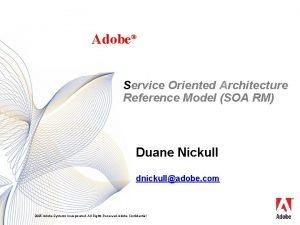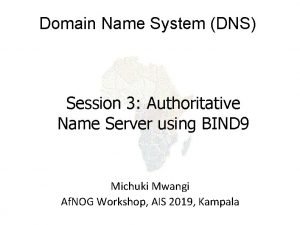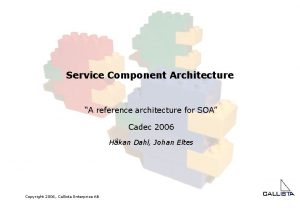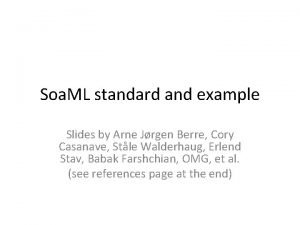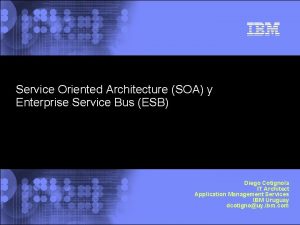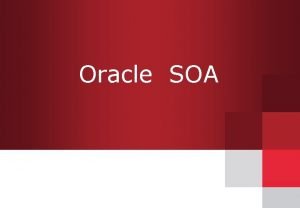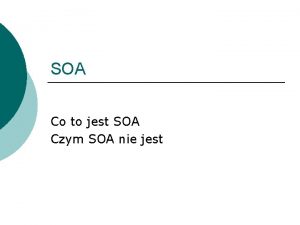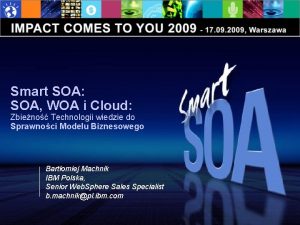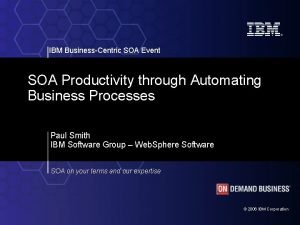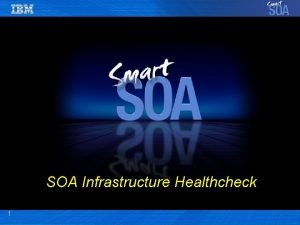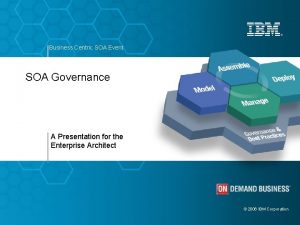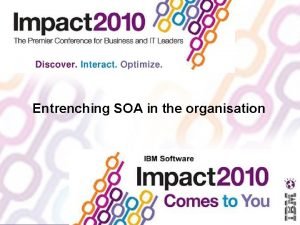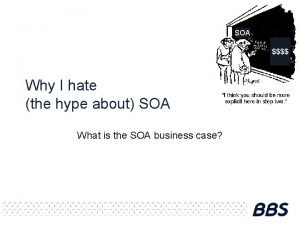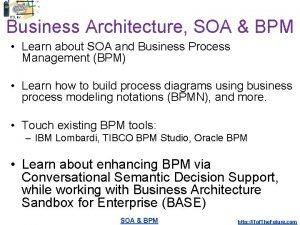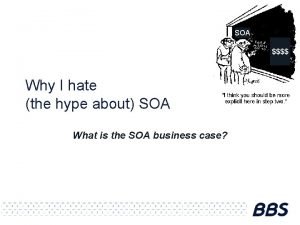www cloud 4 soa eu Outline 1 Cloud



























- Slides: 27

www. cloud 4 soa. eu

Outline 1. Cloud 4 SOA at a glance 2. Motivation 3. Core functionalities 4. Cloud 4 SOA Architecture 5. Cloud 4 SOA’s solution timeline & availability 6. Correlation with CAMP 7. Leassons learnt 8. Questions

Cloud 4 SOA at a Glance q EU Funded Project q Research Programme: FP 7 -ICT-2009 -5 - Objective 1. 2 q Project coordinator: ATOS (Spain) q Partners: (8 partners – 6 Countries) • National University of Ireland Galway (Ireland) • Singular. Logic (Greece) • Centre for Research and Technology Hellas (Greece) • Cloud. Control (Germany) • Cyntelix (NL) • Portugal Telecom Inovação (Portugal) • Fraunhofer FIT (Germany) • Rom. Telecom (Romania) 3

Cloud 4 SOA Motivation q Paa. S (Platform as a Service) is a new paradigm that enables independent software vendors (ISVs) or organization to create (develop or integrate), deploy, execute, integrate and manage business applications, using a service provided by third party. q The actual Paa. S market is, quite young, chaotic and highly fragmented, and it is foreseen only a partial consolidation process in the next years. q Interoperability, in the close future would help market newcomers 4

Project Vision Cloud 4 SOA will support the application management, (deployment, start, stop etc) and migration by semantically interconnecting heterogeneous Paa. S offerings across different providers that share the same technology, and will facilitate the access and lifecycle management for Cloud-based application developers to the Paa. S offering that best matches their computational needs. The vision of Cloud 4 SOA is to open up the Cloud market to small and medium Platform as a Service (Paa. S) providers, strengthen their market position, and in parallel help to alleviate the vendor lock-in barrier for Cloud developers. The Cloud 4 SOA consortium. . . 5

Interoperability? The project examines semantic interoperability needs related to: the deployment of service instances in several competitive platform offerings (Deployment) the migration of an instancethe federation and governance of run-time information between the (i. e. business logic and data)running instances in a harmonised between two competitive way (in order to be easily providers. comparable) 6

Cloud 4 SOA Show Cases 1) VPN Portal from Rom. Telecom 3) BSCW Shared Workspace System from FIT 7 2) Cloud-enabled SDF from Portugal Telecom

Use Case Model 8


Cloud 4 SOA Architecture Formal representation of information by means of the Cloud 4 SOA ontology. Intelligent Interface to support the user understand the data presented by the interface and efficiently interact with the Toolbox that provides - Harmonized Application data presented. intelligent service publication, Monitoring discovery and matchmaking, - Application SLA Management recommendation and layer migration. Acts as an intermediary between the Cloud 4 SOA platform and the various Paa. S offerings allowing the applications to be independent from specific Paa. S offering implementations. CUSTOM ADAPTERS

Cloud 4 SOA Ontology (1/6) – The Cloud 4 SOA ontology defines the fundamental cloud entities and their core set of properties, together with main relations between them – The entities have been categorized into 5 correlated semantic layers: • User layer • Application layer • Enterprise layer • Platform layer

Cloud 4 SOA Ontology (2/6) – Infrastructure layer:

Cloud 4 SOA Ontology (3/6) – Platform layer:

Cloud 4 SOA Ontology (4/6) – Enterprise layer:

Cloud 4 SOA Ontology (5/6) – Application layer:

Cloud 4 SOA Ontology (6/6) – User layer:

Ontology available under Creative Commons • http: //demo. cloud 4 soa. eu/ontology/

Matchmaking (autowiring …)

App Profile Editor. .

Cloud 4 SOA’s solution timeline & availability and IPR Cloud 4 SOA project finalizes full public release Beta program for public hosted (portal) and local versions (Git. Hub) Some functionalities already available to be consumed: i. e. matchmaking service on line IPR: open-source, looking to Apache licenses

Collaboration with CAMP (1/2) • Cloud 4 SOA has already created 'Adapters' for 6 Paa. S providers: AWS Beanstalk, Cloudbees, Heroku, Cloud. Control, Cloud. Foundry & Open. Shift Experience in existing diversities • A common API is already formulated that covers the needs of these 6 Act as Validation for a possible RI

Collaboration with CAMP (2/2)

Lessons Learnt (1/2) • Interoperability is inversely proportial to market adoption (to the insentive of Vocabularies adoption) -Baby -Paa. S-defined expressivity Adoption -RI varies -Loose Assertion (no-CAMP conformance) What is here? Interoperability -Fixed Vocabularies -Strongly Typed Models -RI capabilities are given -Strict Assertion Policies

Lessons Learnt (2/2) • Almost everything was ideal until we touched the issue of non-archive based devlopment – Injection of source code : inevitable (Openshift, Cloud. Control …) – Who takes the responsibility? • If SLA enforcement comes into play the challenge is even bigger – No concrete monitoring abstraction can be formulated (boundaries between Paa. S / Iaa. S)

Questions after reading the spec(1/2) • Why the Serialization format (JSON) imposes restrictions to the expressivity model that a Paa. S provider should use? ? ? (reminds me of the OWL-S vs WSMO endless war) A reference to an RDF-S model would be satisfactory for the majority of the cases • The reasoning capabilities of each provider should be selected during the RI (WSDL-S analogy)

Questions after reading the spec(2/2) • Who defines CAMP-conformance ? And based on what criteria? • Security features? (Register public keys etc) • Scaling policies requires measuments of metrics that require Application patching (new Relic)

Consortium Follow us at the Linked. In Cloud 4 SOA group! www. cloud 4 soa. eu
 Sentence outline example
Sentence outline example Openvpn oracle cloud
Openvpn oracle cloud Outline google cloud
Outline google cloud Soa data integration
Soa data integration Soa xml
Soa xml Ws security in soa
Ws security in soa Soa reference model
Soa reference model Microservicios vs soa
Microservicios vs soa Hp soa systinet
Hp soa systinet Swim soa
Swim soa 21 bpm
21 bpm River soa
River soa Soa roadmap
Soa roadmap Soa enterprise architecture
Soa enterprise architecture Enterprise integration patterns list
Enterprise integration patterns list Soa-ll1
Soa-ll1 Ibm soa
Ibm soa Poste soa
Poste soa Microsoft service oriented architecture
Microsoft service oriented architecture Soa eai
Soa eai Soa testing meaning
Soa testing meaning Soa reference model
Soa reference model Soa record
Soa record ù
ù Wave soa
Wave soa Pagnol soa
Pagnol soa Soa ml
Soa ml Diego cotignola
Diego cotignola

